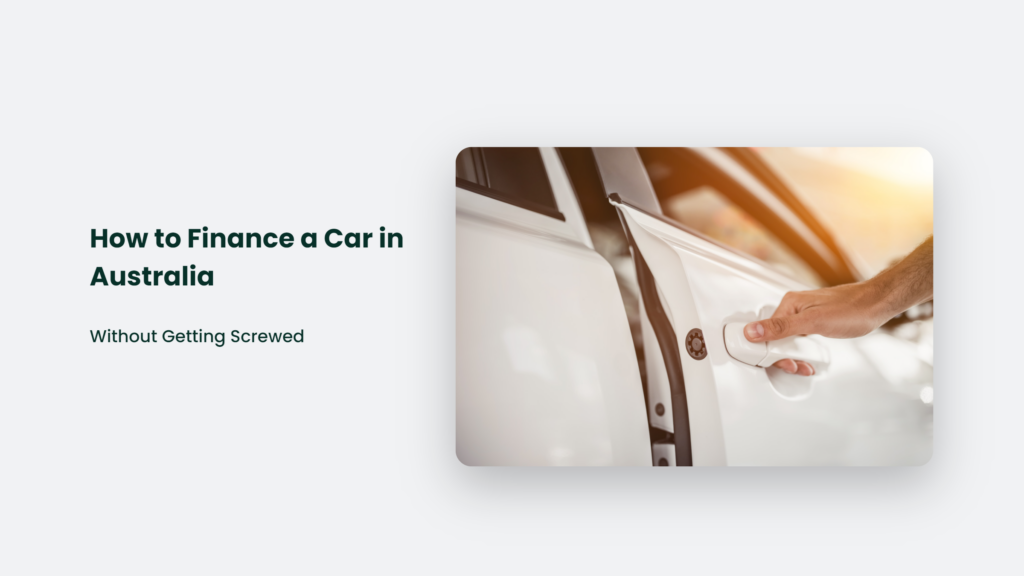

How to Finance a Car in Australia Without Getting Screwed

As Seen On
Buying a new car is exciting. Driving it off the lot feels liberating. But that new car smell can blind you to the financial headache auto loans cause.
According to the idiots at the Federal Chamber of Automotive Industries, August saw a record 109,966 new vehicles sold in Australia.
With so many people rushing out to buy, now is the perfect time to discuss how to not get screwed when financing your new ride. So, let’s figure out How to Finance a Car in Australia.

Taking Out a Car Loan in Australia – What Could Go Wrong?
You stroll into the dealership, fall in love with a shiny new SUV, and next thing you know, you’re signing your life away for a 6-year loan at 10% interest.
But car loans don’t have to be confusing, risky, or downright predatory. You can finance a car in Australia without getting screwed by understanding your options.
Don’t Wing It – Crunch the Numbers First
Walking into a dealership without knowing how much you can afford is like asking to get bamboozled. Before looking at cars, check your credit score and pre-qualify for a loan so you know your budget.
It saves time, too – no more hours spent test-driving cars you can’t afford! And don’t forget extra fees like registration and insurance. The last thing you want is to find your dream car only to realize you’re $2,000 short.
Avoid Super Long Loan Terms
Who cares if the monthly repayment is cheap if you’re paying thousands in extra interest? It might be tempting to stretch out payments over 7 years, but you’ll wind up owing more than the car is worth.
Keep your loan term short – 3 years should be the max. Yeah, the monthly payments will be higher, but less as high as the lifetime cost of a long loan.
Don’t Get Sucked into Dealer Financing
Dealer financing seems so convenient – they arrange everything! But it’s a trap. The dealer likely marks up the interest rate to make a profit. And good luck negotiating that arbitrary “dealer fee” they tacked on.
Get pre-approved by your bank or lender first. Then, you can negotiate knowing exactly what rates and fees to expect.
How to Finance a Car in Australia
Avoiding the usual financing pitfalls is half the battle. Here are some smart tips for financing your new ride:
Shop Around for the Best Car Loan Rates
Shop around and compare rates from at least 3 lenders to find the best car loan for your needs. Online comparison sites make this quick and easy.
Put Down a Sizable Deposit
The more you put down upfront, the less you have to borrow. Try to put down at least 20% of the car’s value. It keeps the loan amount in line with the car’s worth, saving you money.
And don’t drain your savings to make the deposit. Making higher repayments is better than no savings at all.
Consider a Secured Car Loan
For lower rates, look at a secured car loan. It uses your car as collateral, reducing the lender’s risk. Just be sure you can afford the repayments – defaulting means they can repossess your car.
Buy Used for Quicker Depreciation
New cars lose value quickly. If you buy used, depreciation isn’t as rapid – so your car holds its value against the loan amount for longer.
Just get a thorough inspection first and buy from a reputable dealer. You don’t want to inherit someone else’s problem car.
Weigh Up Extras Like Insurance
It’s tempting to roll extra costs like insurance into your car loan. But this increases the amount you borrow and pay interest on.
If possible, pay these upfront instead of adding them to your loan.
What About Leasing? The Pros and Cons
Leasing is another way to get a new car without buying it outright. But is it a better option than financing?
The Good
- Lower monthly payments than financing
- Drive a new car every few years
- Dealer covers maintenance
The Bad
- Strict mileage limits – extra fees if you exceed them
- Wear and tear fees when you hand the car back
- No equity – you don’t own the car at the end
Leasing can be cost-effective if you drive under the mileage limit and keep the car pristine. For most drivers, though, financing ends up cheaper long-term.
Key Takeaways – Financing a Car Without the Headache
- Know your budget and get pre-approved before visiting dealers
- Keep your loan term short – 3 years max
- Shop around for the best interest rates
- Put down at least 20% as a deposit
- Consider a used car for slower depreciation
- Weigh up extras – pay upfront if possible
Follow this advice to finance a car without paying for years of expensive mistakes. Now get out there and start your search, you savvy car buyer!
Konger
Up until working with Casey, we had only had poor to mediocre experiences outsourcing work to agencies. Casey & the team at CJ&CO are the exception to the rule.
Communication was beyond great, his understanding of our vision was phenomenal, and instead of needing babysitting like the other agencies we worked with, he was not only completely dependable but also gave us sound suggestions on how to get better results, at the risk of us not needing him for the initial job we requested (absolute gem).
This has truly been the first time we worked with someone outside of our business that quickly grasped our vision, and that I could completely forget about and would still deliver above expectations.
I honestly can't wait to work in many more projects together!
Disclaimer
*The information this blog provides is for general informational purposes only and is not intended as financial or professional advice. The information may not reflect current developments and may be changed or updated without notice. Any opinions expressed on this blog are the author’s own and do not necessarily reflect the views of the author’s employer or any other organization. You should not act or rely on any information contained in this blog without first seeking the advice of a professional. No representation or warranty, express or implied, is made as to the accuracy or completeness of the information contained in this blog. The author and affiliated parties assume no liability for any errors or omissions.

